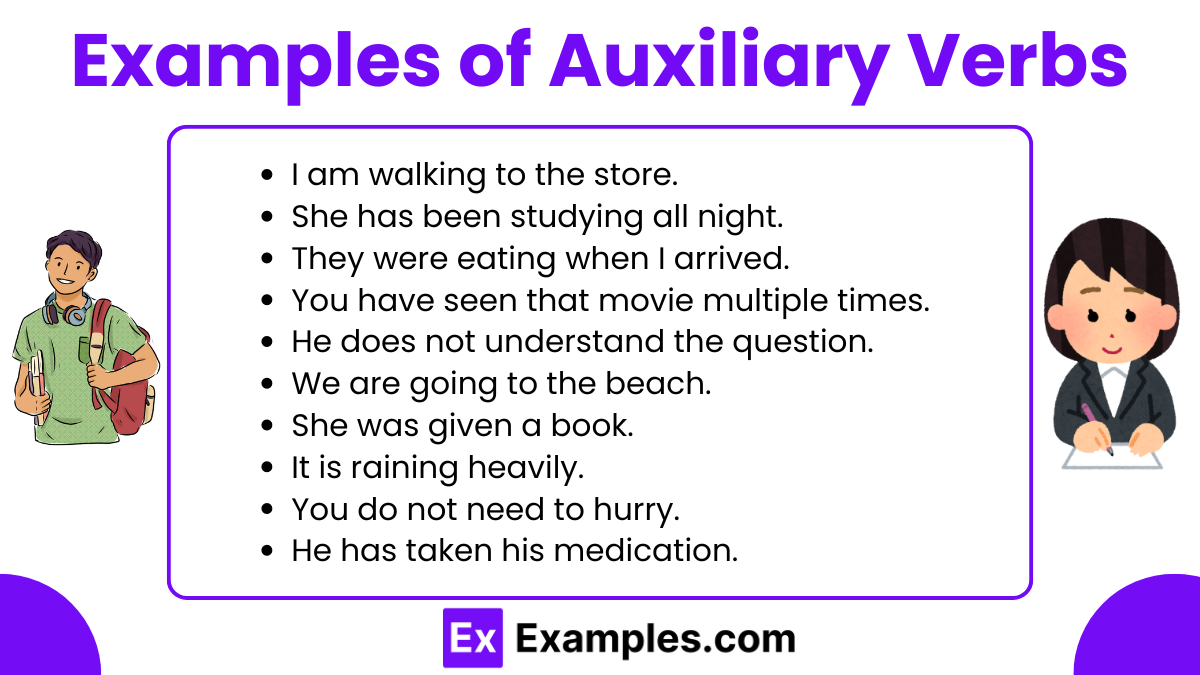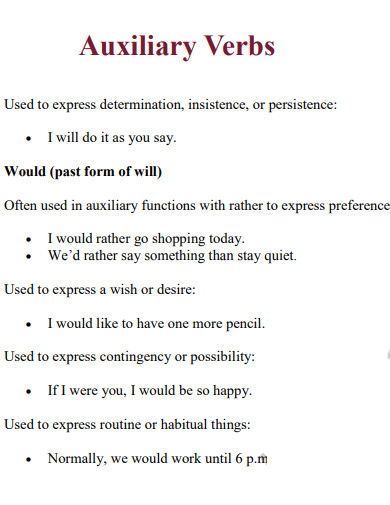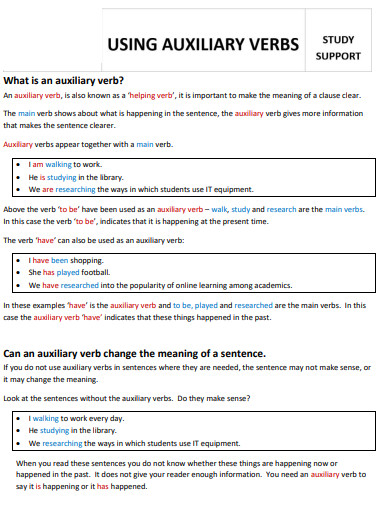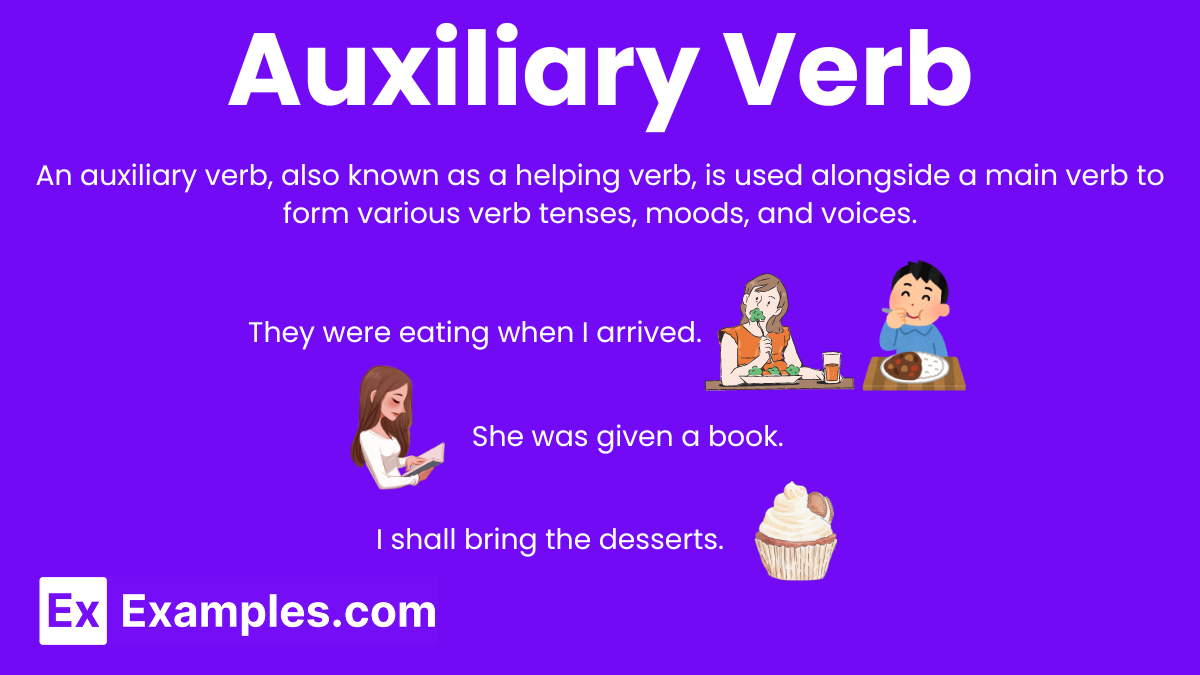30+ Auxiliary Verb Examples
Auxiliary verbs, also known as helping verbs, are essential in English grammar as they support main verbs to form different tenses, moods, and voices. Common auxiliary verbs include “be,” “have,” and “do.” These verbs help express obligations, possibilities, abilities, or permissions when combined with main verbs. For example, in the sentence “She is singing,” “is” helps the main verb “singing” to indicate the present continuous tense. Understanding auxiliary verbs is crucial for constructing clear and correct sentences in English.
What is an Auxiliary Verb?
Types of Auxiliary Verb
1. Primary Auxiliary Verbs:
- Be: Used to form continuous tenses and the passive voice. For example, “She is dancing” (present continuous) or “The song was sung” (passive).
- Have: Helps to form perfect tenses which indicate actions that are completed with respect to other time frames. For example, “I have eaten” (present perfect) or “They had left” (past perfect).
- Do: Used to form interrogative and negative sentences, especially in simple tenses. For example, “Do you like coffee?” (interrogative) or “He does not understand” (negative).
2. Modal Auxiliary Verbs:
- Can/Could: Express ability or possibility. “Can” is used for present abilities, and “Could” is often used for past abilities or polite requests.
- May/Might: Indicate possibility or permission. “May” is more definite, while “Might” suggests a lower probability.
- Will/Would: “Will” is used for future intentions or promises, while “Would” is used for hypothetical situations or polite requests.
- Shall/Should: “Shall” is often used in formal settings to indicate future actions, especially in the first person. “Should” suggests obligation, advice, or probability.
- Must: Indicates necessity or strong obligation.
- Ought to: Similar to “should,” it indicates duty or correctness.
Examples of Auxiliary Verb

- I am walking to the store.
- She has been studying all night.
- They were eating when I arrived.
- You have seen that movie multiple times.
- He does not understand the question.
- We are going to the beach.
- She was given a book.
- It is raining heavily.
- You do not need to hurry.
- He has taken his medication.
- I do like this painting.
- They are being very loud.
- She might join us later.
- We must decide soon.
- They could see the stars.
- I would like some tea.
- She should rest more.
- You mustn’t touch that.
- He can solve the problem.
- They will arrive tomorrow.
- It has been a long day.
- We were dancing all night.
- She does play the piano well.
- I shall bring the desserts.
- You might find it interesting.
- They were driven to school.
- He is taking the train.
- We should help them.
- He must not fail.
- They can hear us.
- I will check the results.
- She has gone to the market.
1. The Auxiliary Verb
2. Basic Auxiliary Verbs

uomustansiriyah.edu.iq
Download
3. Using Auxiliary Verbs

studysupportresources.port.ac.uk
Download
When to Use Auxiliary Verbs
- Forming Tenses: To help form different verb tenses such as present continuous, past continuous, present perfect, and past perfect.
- Creating Negative Sentences: To negate verbs, especially in simple tenses.
- Forming Questions: To convert statements into questions.
- Showing Modality: To express necessity, possibility, permission, or ability.
- Emphasizing Statements: To emphasize the verb they accompany, particularly in responses.
- Forming Passive Voice: To construct passive voice sentences.
- Polite Requests: To soften requests, making them more polite.
- Indicating Future Intentions: To indicate future actions.
How to Use Auxiliary Verbs
Auxiliary verbs, also known as helping verbs, are used alongside main verbs to form tenses, questions, negatives, modality, and passive voice.
Form Tenses
Use auxiliary verbs to create different verb tenses (e.g., continuous, perfect)
Form Questions
Place the auxiliary verb before the subject to ask questions.
Form Negatives
Add “not” after the auxiliary verb to make negative statements.
Express Modality
Use modal auxiliaries to indicate ability, possibility, necessity, etc.
Form Passive Voice
Combine auxiliary verbs with the past participle to create passive constructions.
Tips for Using Auxiliary Verbs
- Ensure Subject-Verb Agreement: Match the auxiliary verb with the subject in person and number.
- Choose the Correct Form: Use the appropriate form of the auxiliary verb based on the tense and voice.
- Inversion for Questions: Place the auxiliary verb before the subject when forming questions.
- Use “Not” for Negatives: Insert “not” after the auxiliary verb to form negatives.
- Differentiate Modals: Use the correct modal auxiliary based on the intended meaning.
- Maintain Consistency: Ensure the auxiliary verb matches the main verb in tense and number.
- Avoid Unnecessary Auxiliaries: Do not include auxiliary verbs when they are not needed.
What is an example of an auxiliary verb?
An example of an auxiliary verb is “is” in “She is running,” where “is” helps form the present continuous tense.
What are the three common auxiliary verbs?
The three common auxiliary verbs are “be,” “have,” and “do,” used to form various tenses, questions, and negatives.
How many auxiliary verbs are there?
There are 24 auxiliary verbs in English, including primary auxiliaries like “be,” “have,” and “do,” and modal auxiliaries like “can,” “could,” “may,” and “must.”
What is an auxiliary verb for kids?
An auxiliary verb, or helping verb, is used with a main verb to show tense or form questions, like “is” in “She is playing.”
How to teach auxiliary verbs in a fun way?
Teach auxiliary verbs using interactive games, songs, and role-playing activities that encourage kids to form sentences with helping verbs.
Is “don’t” an auxiliary verb?
“Don’t” is a contraction of “do not,” where “do” acts as an auxiliary verb to form the negative of a verb.
Can a sentence have only auxiliary verb?
No, a sentence cannot have only an auxiliary verb; it needs a main verb to complete the meaning, like “is going” or “has finished.”
What are Modal Auxiliary Verbs?
Modal auxiliary verbs include “can,” “could,” “may,” “might,” “must,” “shall,” “should,” “will,” and “would,” and they express necessity, possibility, permission, or ability.
How Are Auxiliary Verbs Used in Negatives?
To form negatives, “not” is added after the auxiliary verb, like “She does not (doesn’t) play” or “They are not (aren’t) going.”
Can a Sentence Have Multiple Auxiliary Verbs?
Yes, a sentence can have multiple auxiliary verbs to form complex tenses, such as “He has been working.”




